/Colour illustrations (with the patterns` reconstruction) by Yuri Breivo and Dmitry Tshetinin/
The Chuy valley like Khorezm, Sogd and Fergana was one of the developed centres of the glazed ceramics` production in medieval Central Asia. Archaeologists discovered the potter`s workshops of Karakhanid time with the burning stoves` fragments, made up a good collection of glazed ceramics of the 10-th – 14-th centuries. The potter`s production took a great place in handicrafts of the Chuy valley`s non-nomadic population – settlers from Sogd and Chach, who spoke an eastern Iranian language, and Turkic-speaking tribes. In the 10-th – 12-th centuries, when the territory of modern Kyrgyzstan was a part of Karakhanid state, potters manufactured dishes of various forms, art open hearths, ceramic pipes for water and sewerage, burnt bricks, art tiles and carved terracotta. Researchers attribute the beginning of the mass potter`s production of the Chuy valley`s glazed ceramics to the 10-th century [10, p.61-64]. The 13-th – 14-th centuries are a final stage of development of the potter`s production in the Chuy valley in the Middle Ages and a new period. The production`s cessation of glazed and non-glazed ceramics was connected with decline of medieval towns and settlements, which were not reconstructed after numerous internecine wars and the Mongolian invasion.
This article is based on the ceramics` collections of A.N. Bernshtam`s expedition, non-professional historians N.D. Cherkasov and M.K. Sinusov (which are kept in the Kyrgyz State historical museum). We will try to analyze decor of the Chuy valley`s glazed ceramics, to distinguish main ornamental motives, to examine the ornament`s structure and its colour range.
Four main ornamental motives are used in art glazed ceramics of the Chuy valley of the 10-th – 12-th centuries: vegetable geometrical, “whirlwind rosette”, epigraphic and animalistic motives. Among numerous fragments of ceramic wares with vegetable geometrical ornamentation two big fragments of half-spherical dishes decorated with the composition of the pomegranate`s fruits on the white cream-coloured background draw attention to themselves. The ground of a dish is divided into four sectors. Every sector has a stylized sectional drawing of the pomegranate`s fruit with a black frame like a drop. The images of the pomegranate`s fruits are filled in dark-brown and ochre- coloured spots along horizontal. The fragment of the second dish decorated with the same ornament gives a chance to discern better a square with bended sides, the central element of the composition (ill. 1, 1-2).
In Central Asia the pomegranate`s fruit, one of the main pattern of the composition, symbolized fertility, wealth and happiness from old times onwards. Formerly in the same interpretation the pomegranate`s fruit was known in Ancient Sumer, in cults of Assyria and Phoenicia. From Assyrians the pattern of pomegranate was borrowed and wide-spread later by Arabs, Jews and Greeks [8, p.143]. The sectional drawing of the pomegranate`s fruit has analogies in decor of glazed ceramics of Chach and Taraz of the 10-th – 12-th centuries [4, table 34, 39, 6; 15, ill. 16]. As to the all composition, it can be local.
Except the pomegranate`s fruit another elements of decor wide-spread in Central Asia were used also in ornamentation of the Chuy valley`s glazed ceramics. Among them are fragments of different four-petalled rosettes represented in the centre of dishes on the ochre-coloured background (ill. 1, 3-4).
The drawing of the rosette with narrow petals was made by black paint and was underlined by white contour. The rosette with broad petals was drawn by dark-brown lines. Every petal of the rosette has a black circle with a white point in the centre.
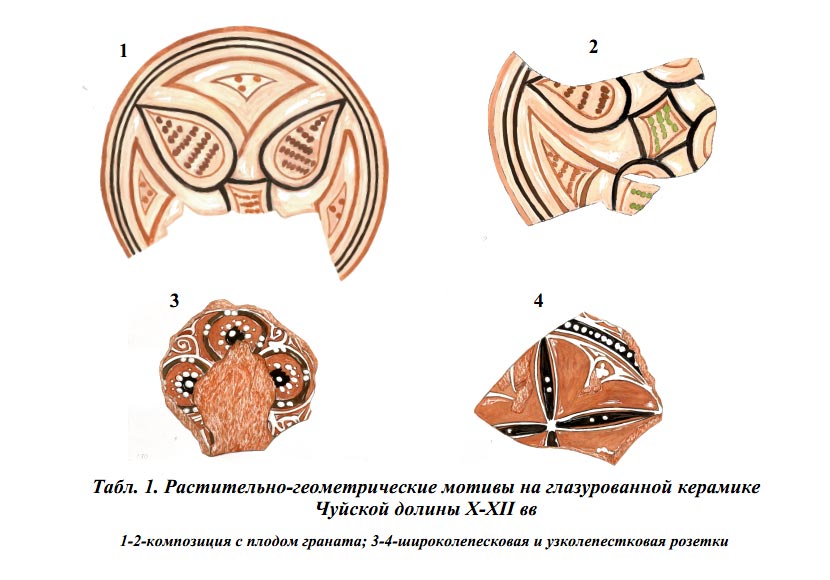
The first element of ornament is analogous to the artists` articles from Sogd of the second half of the 10-th – the beginning of the 11-th centuries [19, p. 59, table LX, 2]. The element of ornament, obviously, has local origin.
In the 10-th – 12-th centuries the motif “whirlwind rosette” was one of the most popular in decor of glazed ceramics of Central Asia. This ornamental motif has ancient historic sources dating back to the first centuries B.C. According to the scientists` opinion the rosette with curved petals originated from Scythian- Sarmatian archaeological complexes and embodied a solar symbol [6, p.216; 18, p.90]. Whirlwind rosettes represented in the centre of the Chuy glazed dishes of the 10-th – 12-th centuries are an independent kind of decor. The rosettes are fulfilled with a high art skill in different style and colour range. Medieval artists painted the patterns by energetic picturesque touch intensifying their dynamics and expressiveness. The Chuy valley`s rosettes can be united into six groups by their colour and stylish peculiarities (ill. 2-3).
The first group includes dark-brown whirlwind rosettes on the white background with a cream-coloured or a yellowish hue; the second group – ochre-coloured whirlwind rosettes on the white or white background with a yellowish hue. The third group is represented by dark and dark-brown rosettes on the white background with a greenish hue. The fourth group is formed of dark or dark-brown whirlwind rosettes with brown and light-green petals painted on the white background with a greenish hue. The fifth group can be illustrated by a dark whirlwind rosette on the white background with a greenish hue; the last group – a rosette with white and light-brown petals on the dark background. Often the drawing of the ornamental motif is completed by a frame of double curls made by dark and dark-brown paint.

The whirlwind rosettes of the first, second and fifth groups find their numerous analogies in glazed ceramics of the 10-th – 12-th centuries of Sogd, Chach, the Talas valley and Southern Kazakhstan [19, table LIX, 3, LХIV, 4; 4, table 5, 1, 37, 3-4; 11, table I; 1, ill. 39]. The Chuy rosettes are like the Sogdian ones by their colour range: in Sogd, as in the Chuy valley, artists preferred to paint the whirlwind rosettes by ochre-coloured or dark-brown colour [4, p. 57; 16, p. 124]. The rosettes of the third, fourth and sixth groups, evidently, are local versions of the wide-spread kind of decor.
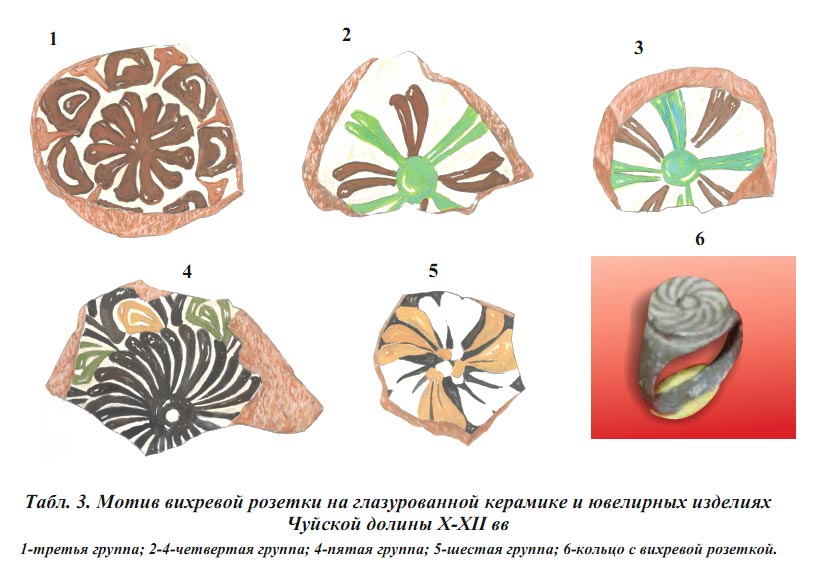
Except the potter`s production the motif “whirlwind rosette” was also wide-spread in other types of Central Asian applied art. As the collection of Dr. A.M. Kamyshev shows, the pattern decorates the Chuy valley`s jewelry wares of the 10-th – 12-th centuries (ill. 3, 6). In Khorezm and Tashkent artists made the image of whirlwind rosette, which was a remedy of “a bad eye”, in carved doors of the 19-th century. The same motif we can find in ornamentation of carpets and wooden wares of Kyrgyzes calling it “kun” – “sun” [4, p. 56; 9, table XIV, 1].
Epigraphic decor represents stylized repeated words and letters which were made by the kufic handwriting with white, black, dark-brown and ochre-coloured paints. The Arabic inscriptions are situated along the side and bottom of dishes.
Let`s examine a few examples. A dark-brown inscription decorates the white bottom of the ceramics` fragment. Only the inscription`s beginning – the syllable “lah”, can be read. The repeated inscription “Allah” is known in the Chuy glazed ceramics of the 10-th – 12-th centuries (from a collection of Dr. A.N. Bernstam). The white inscription “al-yumn” (prosperity) including the incomplete word of the three letters “alif”, “lam” and “nun” is represented in another fragment of ceramics (ill. 4, 2-3). The letters painted on the ochre-coloured background are broad and long, the end of the letter “nun” rises to the level of “lam” and “nun”. Analogous inscriptions were found in glazed ceramics of Chach and Khorezm of the 10-th – 11-th centuries [4, table 38, 1; 5, ill. 9,11].
Another kind of inscriptions we can see in a big fragment of a half-spherical dish with the white background of a cream-coloured hue (ill. 4, 1). The frieze with epigraphic ornament is situated between two dark-brown lines and divided into four sectors by two double dark-brown “drops”. The epigraphic ornament consists of ochre-coloured inscriptions which remind two repeated Arabic letters “alif” and the letter “ha”. These inscriptions have analogies in glazed dishes of Khorezm of the 10-th – 11-th centuries [5, ill. 11,14].
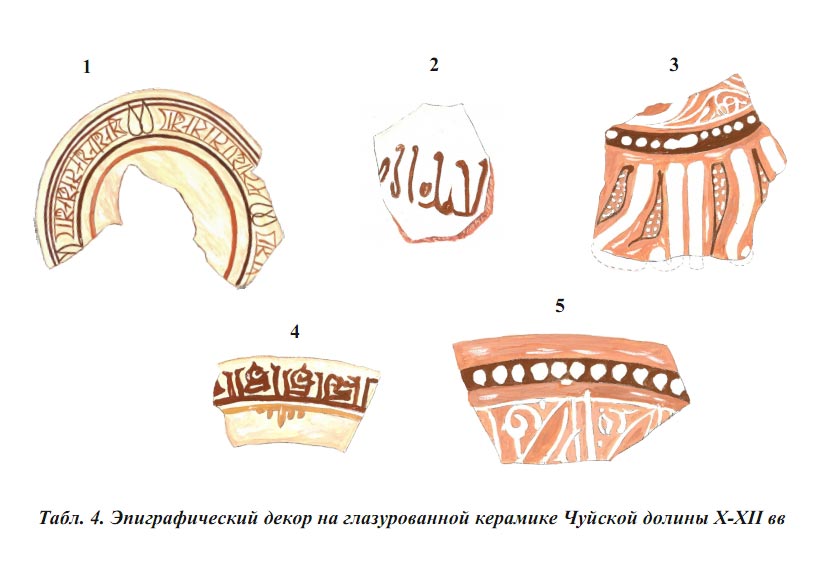
The ceramics with animalistic images have a great importance for historical and cultural characteristics of every region, town or settlement; exactly determinate animals can help to reproduce the ancient notions of people about the world and nature. Only a few animalistic images are known on the Chuy glazed dishes of the 11-th – 12-th centuries. One of them is the running pheasant`s image on the glazed dish, discovered by Dr. A.N. Bernshtam in 1941 (ill. 5, 1). A medieval artist reproduced the peculiarities of the body`s form, the habits of the pheasant, its typical motions with a great reliability and good measure of generalization. The pheasant`s image is an integral part of the ornamental system: the composition and colour range of the animal are connected with the epigraphic ornament and black spots, situated along the dish`s brim. The epigraphic ornament is a group of stylized Arabic letters, which fulfill, in all probability, solely the decorative function. Gracefully bordering the dish, beautiful light brown letters and black spots, situated slightly higher, complete and sum up the all image. The dish`s composition stands out for its simplicity and laconism. In spite of the black colour`s presence in the paintings, the colour range of the dish is warm and idle. The technique`s immaculateness, clear and confident drawings, harmony between background and paintings, beautiful combinations of colours testify to the great skill of the artist.
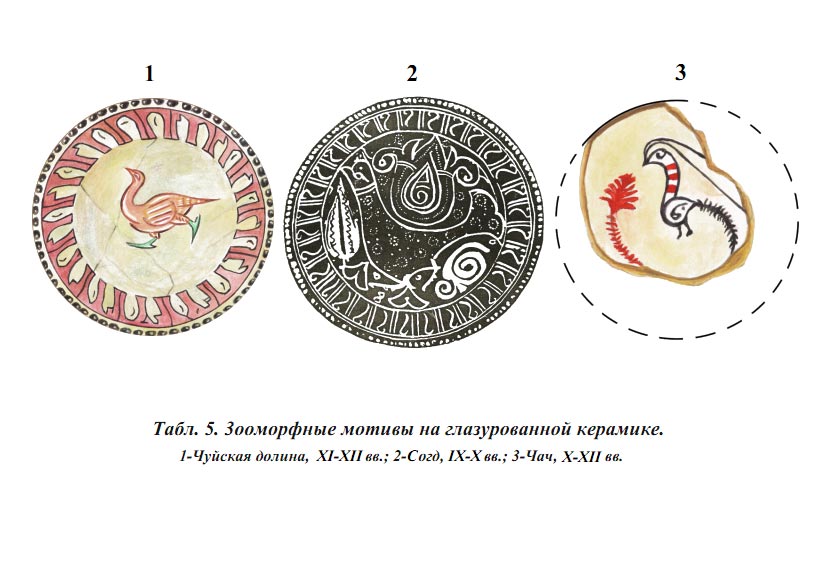
The pheasant`s appearance in the decoration of the Chuy valley`s glazed dish, of course, was not accidental. From old times onwards in Central Asia this animal is considered a sacred bird, a symbol of fire and victory [4, p. 71]. Beginnings of the pheasant`s cult, according scientists` opinion, were connected with the spreading of Zoroastrianism in Iran and Central Asia. In the Chuy valley the Iranian-speaking settlers from Sogd and Chach confessed Zoroastrianism [7].
Besides, with the exception of the Chuy valley the pheasant`s image we can find also on glazed ceramics of Sogd of the 9-th – 10-th centuries and Chach of the 10-th – 12-th centuries [13, table XXII; 4, table 46,9]. As compared with the realistic portrayals of the pheasant on the Chuy dish, the birds, fulfilled by artists from Sogd and Chach, are conventionalized and have a certain likeness with vegetable and geometrical ornaments. At the same time it is necessary to note that the Sogd and Chuy dishes have one and the same composition: in the centre of the dishes the pheasant`s portrayals is situated, and the brims are decorated with the epigraphic ornament and spots (ill. 5, 2-3). It is possible that the Chuy artist, the author of the glazed dish with the pheasant`s image, was under the strong cultural influence of Sogd.
Now let`s concentrate our attention on glazed ceramics of the Chuy valley of the 13-th – 14-th centuries. Its decor is divided into vegetable, vegetable geometrical, “whirlwind”, lineal geometrical and animalistic ornamental motives.
Among vegetable motives images of eight-petalled rosettes wide-spread in the Chuy glazed ceramics have a special interest. The rosettes are fulfilled at the bottom of the dishes` fragments in three different versions. One of the eight-petalled rosettes is painted by dark-blue contour on the blue-white background (ill. 6, 1). There is a circle with a segment in the rosette`s centre, and every petal has an ornamental element in the form of a drop. A medieval artist painted the rosette carefully and neatly, with the attention to every detail. There are no unnecessary and spontaneous touches in the paintings. The all elements of the pattern are connected with each other and united in an indivisible and finished image.
Another interpretation was given to other eight-petalled rosettes which differ from the first one both their style of performance and their colour range. These rosettes have more simple and generalized form, but it is compensated for good colour combinations. One of them is represented by light-green paint on the emerald green background. Another eight-petalled rosette also has a picturesque and attractive form: its white and blue petals are underlined by black colour (ill. 6, 2-3). The Chuy rosettes find close parallels with eight-petalled rosettes in glazed dishes of Khorezm of the 14-th century, in the stamp`s fragment and stamped ceramics of Merv of the 12-th – 13-th centuries [5, ill. 30; 11, ill. 35, 57].

Vegetable motives decorating the Chuy glazed ceramics of this period include also the dishes` fragments with a four-petalled rosette and flower bud on the white background (ill. 6, 4-5). The four-petalled rosette made by blue contour is situated at the dish`s bottom. Every petal of the rosette has a stylized leaf draw by black lines with a blue point inside. In the centre of the rosette a quadrangle fulfilled by black lines includes a dark-blue circle and a blue oval.
The flower bud painted by light-blue colour decorates the side`s fragment of the plate. The bud has a blue stylized leaf inside, and a white four-petalled rosette is in the leaf`s centre.
A small fragment of highly glazed pottery also gives an example of vegetable ornamentation. Its complicated pattern was painted by black colour on the bright-blue background (ill. 6, 6).
There are no exact analogies for a four-petalled rosette and a flower bud. However the elements forming these ornamental motives – stylized leaf, quadrangle, four-petalled rosette with round petals are well-known in glazed ceramics of Samarkand and Chach of the second half of the 11-th – 12-th centuries and are used in glazed dishes of Khorezm of the 13-th – 14-th centuries [4, table 42; 17, ill. 24, 26, 31; 5, ill. 29]. According to the notions of Central Asian farmers, the above-mentioned flower vegetable motives and rosettes were connected with Navruz, a spring holiday, and embodied awakening nature [8, p. 157-158].
Vegetable geometrical motives are represented in the Chuy dishes by ceramic fragments with a few complicated compositions (ill. 6, 7-8). The first composition consists of an eight-petalled rosette including a four-beam star and a rosette with four narrow petals. The drawing is not made by a brush; it is scratched by a sharp tool on the white engobe. Thanks to this art way an artist could fulfill every element of the composition in detail and could use natural brown colour of the fragment. Numerous light-green spots decorating the rosette with narrow petals and four-beam star give a picturesque and dynamic shape to the drawing.
The second vegetable geometrical composition situated also at the dish`s bottom has a rectangle with light-blue quadrangles at its ends. The light-blue “hearts” with thin black lines are painted on the figure`s sides. The pleasant colour range of the composition includes the combination of light-blue, white and black tones. Both vegetable geometrical compositions have no analogies and, very likely, were typical only for decor of the Chuy valley`s glazed ceramics of the 13-th – 14-th centuries.

A pattern of two ovals with sharp ends give an example of geometrical ornamentation. The light-blue ovals fulfilled on the white background are underlined by black contour which makes the pattern clearer and exacter (ill. 7, 2). Such geometrical ornament is analogous to glazed ceramics of Merv of the 10-th -the early 11-th centuries [12, ill. 15, p. 244].
The “whirlwind” motif decorating two small ceramic fragments attracts our attention by its simple form. A group of black points disposed along the circle are visible on the white cream-coloured background of the first fragment. A circle with spots and a curved petal is represented by dark-brown paint on the light-blue background of the second fragment (ill. 7, 3-4). Both drawings situated at the dishes` bottom, most probably, are late simplified versions of the motif “whirlwind rosette”, which was wide-spread in the 10-th – 12-th centuries in Central Asian glazed ceramics. Analogous patterns are known in glazed dishes of Otrar and Khorezm of the 13-th – 14-th centuries [1, ill. 68, 3; 5, ill. 27, 7].
Simple compositions of three strips represented on the grayish or light-green background belong to lineal geometrical ornamentation. The widening strips go from the centre, which is at the dishes` bottom. The lineal geometrical compositions are made in two main versions. In the first version strips are painted by two brown contours and decorated with wavy brown lines and blue or brown spots. In the second version double contours of strips and wavy lines are fulfilled by grassy green paint on the light-green background (ill. 7, 5-7). This composition, obviously, also would be local.
The only example of animalistic motif of the Chuy glazed ceramics of the 13-th – 14-th centuries can be a fragment of the dish`s side. The side is decorated by stylized images of animals like goats which are situated between two parallel lines. The paintings are made by grassy green colour on the blue background (ill. 7, 8).
Thus, we finished the survey of ceramics and must make note of a great likeness of the glazed dishes` ornamentation of the Chuy valley with ceramics from other regions of Central Asia and Southern Kazakhstan. It is testified that intensive economic and cultural contacts existed in the Middle Ages. Small numbers of colours were used in paintings, but the Chuy glazed ceramics has a great art quality: variety of ornamentation made on a high professional level, and harmony of colour combinations. The brush`s free touch creates decorative lines and spots on the surface, which are perceived as a united art image with the all plane and background of an article. In the 13-th – 14-th centuries the art shape of the Chuy valley`s glazed ceramics changed essentially. The ornamental motives wide-spread in decor of Central Asian glazed ceramics of the 10-th – 12-th centuries were interpreted in the Chuy dishes in a new fashion. The motif “whirlwind rosette” is represented either in the form of points disposed along the circle or it is transformed in a circle with spots and curved petals. The drawing of eight- and four-petalled rosettes got complicated by four- beam stars, rosettes with narrow petals, stylized leaves and quadrangles. Unlike decor of the Chuy valley`s glazed ceramics of the 10-th – 12-th centuries, where black colour and brown hues dominated, dark-blue and blue tones used as a background or in the painting of main ornamental elements took a great place in the ceramics` colour range of the 13-th – 14-th centuries. The interest of Central Asian artists to blue colour researchers connect with the Chinese porcelain`s influence of the type “cobalt” [14, p. 207]. The production`s technology of the Chuy glazed ceramics remained as in the 10-th – 12-th centuries: dishes were made with the help of the potter`s wheel, and decor was painted on engobe before the glaze`s coating.
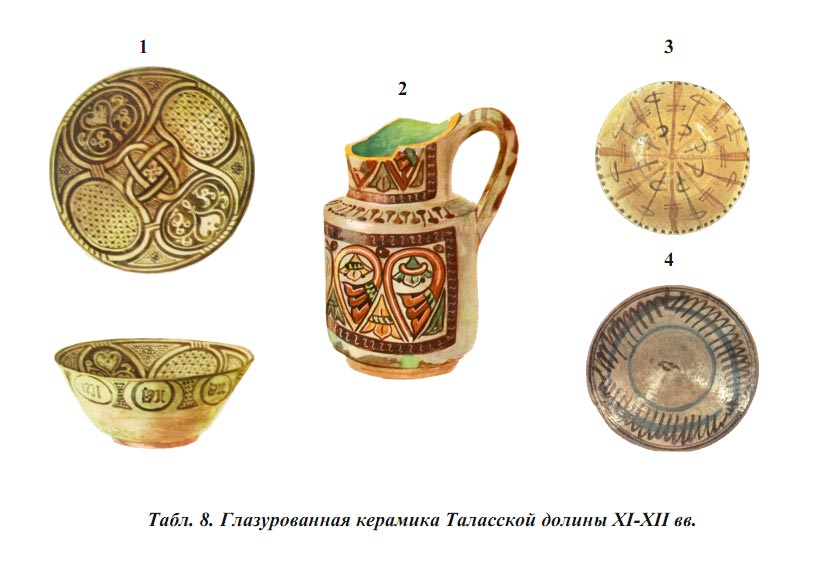
1.Акишев К.А., Байпаков К.М., Ерзакович Л.Б. Древний Отрар. – Алма-Ата, 1972.
2. Ахраров И. Керамика Ферганы IX – XII вв. Автореф. канд. дисс. – Ташкент, 1964.
3. Байпаков К.М. Средневековая городская культура Южного Казахстана и Семиречья (VI – начало XIII в.). – Алма-Ата, 1986.
4. Брусенко Л.Г. Глазурованная керамика Чача IX – XII веков. – Ташкент, 1986.
5. Вактурская Н.Н. Классификация средневековой керамики Хорезма (IX – XVII вв.) // ТХЭ. Т. IV. – М., 1959.
6. Горячева В.Д. Городская культура тюркских каганатов на Тянь-Шане (середина VI – начало XIII в.). – Бишкек, 2010.
7. Григорьев Г.В. Тус-Тупи. – Искусство, 1937, № 1.
8. Исмаилова-Мамедова Э. Ковры уйгуров // Материалы по истории и культуре уйгурского народа. – Алма-Ата, 1978.
9. Киргизский национальный узор / Матер. собр. и обработ. М.В. Рындиным. Под общ. ред. И.А. Орбели. Вступ. статья А.Н. Бернштама. – Л.-Фрунзе, 1948.
10. Кожемяко П.Н. Раннесредневековые города и поселения Чуйской долины. – Фрунзе, 1959.
11. Кожемяко П.Н. Оседлые поселения Таласской долины //Археологические памятники Таласской долины. – Фрунзе, 1963.
12. Лунина С.Б. Гончарное производство в Мерве X – начало XIII в. // ТЮТАКЭ. Т. XI. 1962.
13. Майсурадзе З.П. Керамика Афрасиаба. – Тбилиси, 1958.
14. Пугаченкова Г.А., Ремпель Л.И. Очерки искусства Средней Азии: древность и средневековье. – М, 1982.
15. Сенигова Т.Н. Орнаментальные узоры на керамических сосудах VI – IX вв. // В глубь веков. – Алма-Ата, 1974.
16. Столярова Н.Т. Орнаментация глазурованной керамики IX – начала XIII вв. Кашкадарьи // Древняя и средневековая археология Средней Азии. – Ташкент, 1990.
17. Ташходжаев Ш.С. Художественная поливная керамика Самарканда IX- начала XIII вв. – Ташкент, 1967.
18. Тревер К.В. Памятники греко-бактрийского искусства. – М.-Л., 1940.
19. Шишкина Г.В. Глазурованная керамика Согда (вторая половина VIII – начало XIII в.). – Ташкент, 1979.